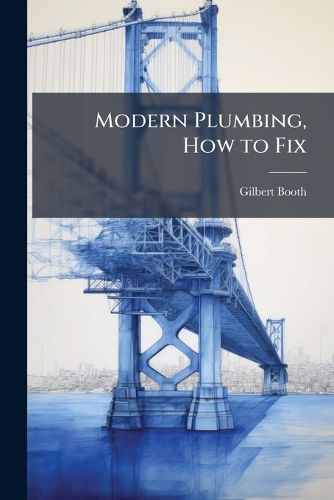Readings Newsletter
Become a Readings Member to make your shopping experience even easier.
Sign in or sign up for free!
You’re not far away from qualifying for FREE standard shipping within Australia
You’ve qualified for FREE standard shipping within Australia
The cart is loading…






Discover the secrets of early 20th-century plumbing with "Modern Plumbing, How to Fix," a comprehensive guide by Gilbert Booth. Originally published in 1916, this book offers a fascinating glimpse into the plumbing techniques and materials of a bygone era.
While modern plumbing has advanced significantly, understanding the fundamentals presented in this volume can provide valuable insights into the history of home construction and repair. Explore detailed instructions and diagrams that illustrate the methods used to install and maintain plumbing systems in the early 1900s. Whether you're a history enthusiast, a vintage home restorer, or simply curious about the evolution of plumbing, this book is a unique resource.
This work has been selected by scholars as being culturally important, and is part of the knowledge base of civilization as we know it. This work was reproduced from the original artifact, and remains as true to the original work as possible. Therefore, you will see the original copyright references, library stamps (as most of these works have been housed in our most important libraries around the world), and other notations in the work.
This work is in the public domain in the United States of America, and possibly other nations. Within the United States, you may freely copy and distribute this work, as no entity (individual or corporate) has a copyright on the body of the work.
As a reproduction of a historical artifact, this work may contain missing or blurred pages, poor pictures, errant marks, etc. Scholars believe, and we concur, that this work is important enough to be preserved, reproduced, and made generally available to the public. We appreciate your support of the preservation process, and thank you for being an important part of keeping this knowledge alive and relevant.
$9.00 standard shipping within Australia
FREE standard shipping within Australia for orders over $100.00
Express & International shipping calculated at checkout
Stock availability can be subject to change without notice. We recommend calling the shop or contacting our online team to check availability of low stock items. Please see our Shopping Online page for more details.
Discover the secrets of early 20th-century plumbing with "Modern Plumbing, How to Fix," a comprehensive guide by Gilbert Booth. Originally published in 1916, this book offers a fascinating glimpse into the plumbing techniques and materials of a bygone era.
While modern plumbing has advanced significantly, understanding the fundamentals presented in this volume can provide valuable insights into the history of home construction and repair. Explore detailed instructions and diagrams that illustrate the methods used to install and maintain plumbing systems in the early 1900s. Whether you're a history enthusiast, a vintage home restorer, or simply curious about the evolution of plumbing, this book is a unique resource.
This work has been selected by scholars as being culturally important, and is part of the knowledge base of civilization as we know it. This work was reproduced from the original artifact, and remains as true to the original work as possible. Therefore, you will see the original copyright references, library stamps (as most of these works have been housed in our most important libraries around the world), and other notations in the work.
This work is in the public domain in the United States of America, and possibly other nations. Within the United States, you may freely copy and distribute this work, as no entity (individual or corporate) has a copyright on the body of the work.
As a reproduction of a historical artifact, this work may contain missing or blurred pages, poor pictures, errant marks, etc. Scholars believe, and we concur, that this work is important enough to be preserved, reproduced, and made generally available to the public. We appreciate your support of the preservation process, and thank you for being an important part of keeping this knowledge alive and relevant.